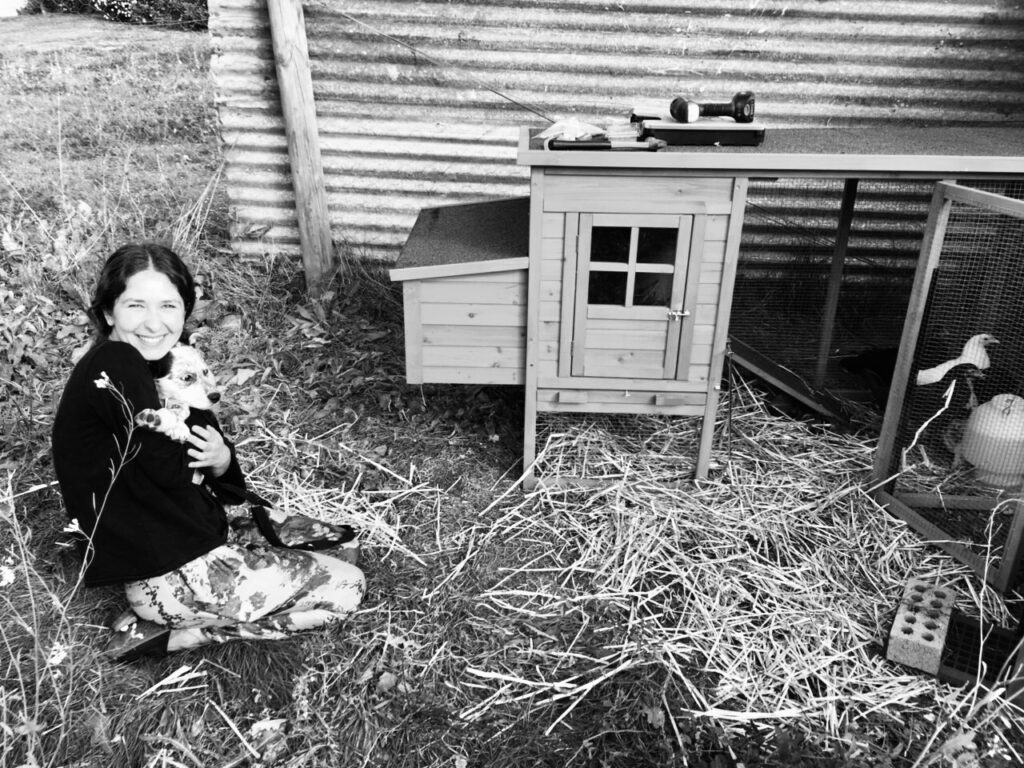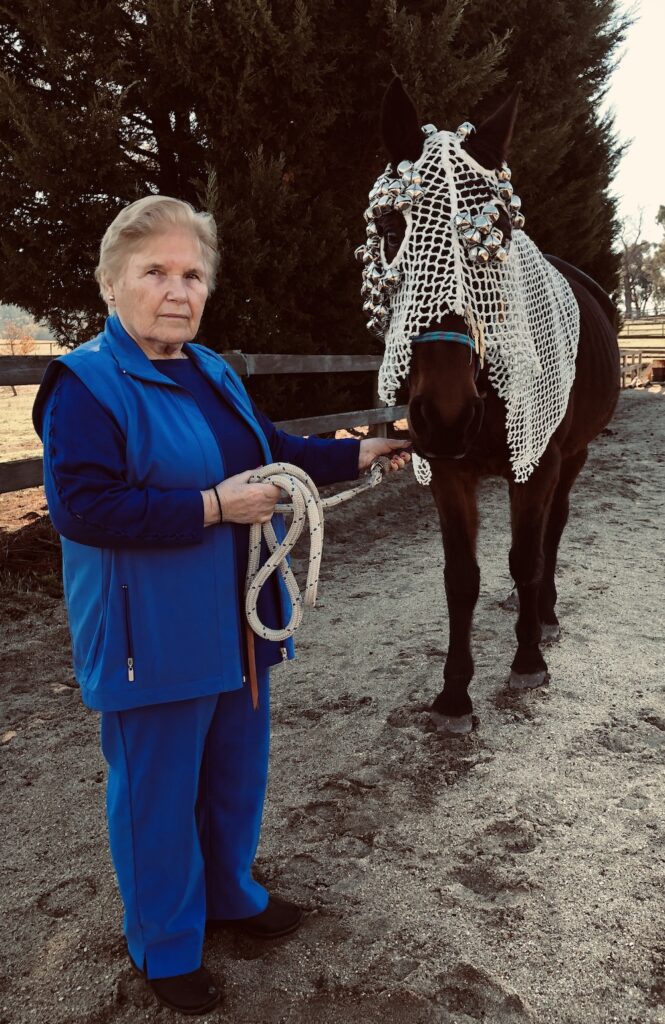Tina Stefanou is one of 10 artists whose work will be exhibited in ‘Rural Utopias’, at the Art Gallery of WA. Ahead of the opening, we’re re-sharing her 2020 reflection on the role of an artist, in a time that is characterised by economic, social, political and environmental injustice.
A walk with Tina Stefanou
17 November 2023
- Reading time • 10 minutesVisual Art
More like this
- Waves of influence span an ocean
- A blaze of glorious people
- Diving into the gothic world of Erin Coates
Melbourne-based artist Tina Stefanou works across performance, voice, sculpture, painting, video and sound. She explores the relationship between the human voice and the voice of things, ideas and situations. Influenced by her immediate environment she collaborates with sites, family members, non-singers, children, musicians and animals.
Stefanou’s work is informed by diasporic experiences and the exploration of non-Anglo cultural expression, and is also based on living with little and making do with what is available, focusing on practice rather than production.
As we emerge in and out of different levels of crisis, including the ones we were already in before the virus, I am questioning the attitudes, habits, practices, assumptions and taken-for-granted realities of the everyday.
I’ve become more and more suspicious of most things, including my own aspirations – the virus has only sped up these suspicions. I am not referring to conspiracy theories, but rather, questions around forms of production, the politics of living and dying, class disparities, relationships to Earthly living systems and the drive to live through vertical ascent. Individualism has become the altar where personal accumulations of capital are central. Resources are used at any cost for certain individuals to prosper.

Of course this is not everyone: I am referring to the affluent classes. There have been many populations and communities in the past and present that are in forced isolation and crisis, where resources and freedoms are limited and controlled. Not to mention the ongoing crisis for Indigenous communities locally and abroad.
The individual extends and is embedded within complex webs of human exceptionalism, and the military-industrial-political-capital entanglement. As a lucky one – who is part of the educated class but situated within immigrant working class stories – I have recently been upgraded from unemployed student to dole bludger/JobSeeker: what should really be called ‘Life Keeper’. Now that the elite, upper and middle classes are affected by global disparities and bio-political implications, some of the vulnerable and unemployed are considered worthy of living right on the poverty line, instead of below it… but for how long will this act of social service last and what happens to those who are not receiving these benefits?
Now that the elite, upper and middle classes are affected by global disparities and bio-political implications, some of the vulnerable and unemployed are considered worthy of living right on the poverty line, instead of below it… but for how long will this act of social service last and what happens to those who are not receiving these benefits?
When I first got wind of the pandemic, my impulse was to plant food, collect firewood for winter, make a home for some hens, care for the vulnerable in my community, and focus on companionship. My day to day practice has been altered towards these activities, where awareness of my environment has heightened and nurturing has become central. This has led me to a series of reflections on artistic practice in times of extinction and crisis. My thoughts are discursive and made up of many islands that are still forming. I share them with you, as if you and I were going for a walk.
Over the last year my art practice has turned toward different life orchestrations, from learning how to keep plants alive to feed my small community from no-dig garden beds, to communicating across multiple perceptual realties with chickens, dog, birds, horses and other local collaborators, to caring practices with my grandmother and family.

What does this mean moving forward? How do I move away from art commodities into other configurations of artistic practice? Where is the artwork? Can art function away from self-interest and human exceptionalism? These pragmatic turns to the maintenance of the everyday physical realities across species and bodies, are echos from peasant pasts, grandmother wisdoms and more-than human labour interfaces.
Instead of networking towards an ascending self-brand, the ‘I’ becomes embedded in a daily meshwork of living and flourishing – with and for others. Here, the practice is not attributed to an author – it is situated among community and ecosystems, rather than art markets and scenes. I stand in solidarity with the workers, eco-systems, immigrants, reproductive justice, and the flourishing of all living creatures on Earth.
This is not a utopic stance, a Gaia trance, for the buzzed-out beautiful naturalists who can afford organic produce, at times I have fallen into these spaces too. There is a lot of work to be done in order to find new ways of being-in-practice and life in times of increasing eco-bio-social crisis. I am thinking about what is at the core of my practice: is it accessible, what is accessibility and to whom is it accessible? What is my responsibility? What internal and external resources am I drawing from? The playful dimensions of living within local and immediate spaces provides opportunities to re-orientate, re-position and take what is at stake very seriously. Here, I may be able to find a consistent language that is not contained within the readable, writable or sayable, but is also rooted within grounded physical realities, for new perceptual and aesthetic relationships to reach out for connection to others.
As we enter further complexities and questions around how we are in the world and what worlds are at stake, talk of the “new” normal should be resisted. Yes, plans have to change. Yes, practices need to shift, but questions of ‘how’ and ‘what’ need to be scrutinised by the state, communities and the individual.
Yes, plans have to change. Yes, practices need to shift, but questions of ‘how’ and ‘what’ need to be scrutinised by the state, communities and the individual.
I feel a surge toward the unspeakable, undefinable and in-motion. I think about the conditions of pandemic realties that we have participated in and supported, through one form or another, and how new forms of solidarity with humans and more-than-humans can evolve within these neoliberal constructions and mass extraction technologies. Art practice and aesthetic configurations do not form in isolation from other happenings and makings, even if aspects of art environments do. Can aesthetic cognitions re-imagine hierarchies and create deeper resonance between bodies and places? My thoughts and ideas weave in and out with the thoughts and ideas of others, recycling and composting, towards understandings that do not stand over anyone or anything. Rather, it is closer to Earth, to what is underneath, to learn, to humble, to not-know, to stand under.
Practice is located within responses and abilities to living bodies and systems. How can I hold both the personal and the global? Multi-scalar realities reside within my body and the spaces in which I dwell. Whose labour is involved in making my voice possible? What material extractions, cultural capital and story-making apparatuses am I unconscious of? What cellular microbial actors are assisting in this thick present that spans generations?
Nothing is straight forward. Language is deceptive and complexity shines true.
Nothing is straight forward. Language is deceptive and complexity shines true. I return to a simple walk – passing dams, taking in the sunlight and watching kangaroos pass by. I am seeking long-lasting engagement through temporal realities, where the art practice is not supreme. Instead, it is part of and contributing to questions of meeting – how can we meet?
Perhaps, friendship is a good place to land on as we walk – friendship not as a methodology, medium, strategy or extraction. Perhaps practice can re-configure through friendship – where other forms of participation can move away from apocalyptic fetishism and crisis capitalism. Where the brutal reality for so many to simply survive is not swiped away, where multiple experiences of living and dying are supported through diverse skills, resource sharing, economic transparency and alternative forms of currency. These types of participations are not limited, mediated or curated. Without solutions, I stand with you in the complexity, not towards hope and not towards despair. But towards friendship, as we walk further into crisis.
Tina Stefanou, May 2020
Pictured top: Tina Stefanou, ‘Shimmer’, 2019, colour film. Photo: Andrew Kaineder
Tina Stefanou is one of 10 artists taking part in SPACED’s Rural Utopias project, which sees artists live and work in remote and regional WA communities, developing original art projects in response to those places.
The art works resulting from this project will be exhibited at the Art Gallery of Western Australia, 25 November 2023 – 18 February 2024. The new works will be displayed alongside works that resonate with each of the projects and the theme of Rural Utopias, selected from the State Art Collection by the artists, alongside curator Miranda Johnson.
Like what you're reading? Support Seesaw.





